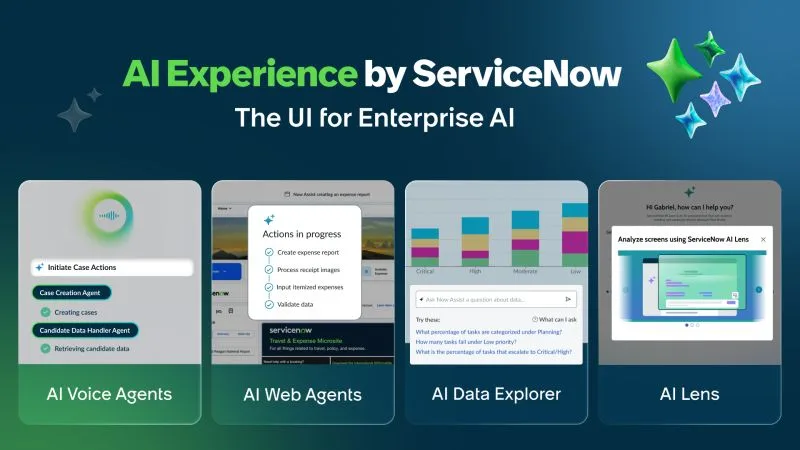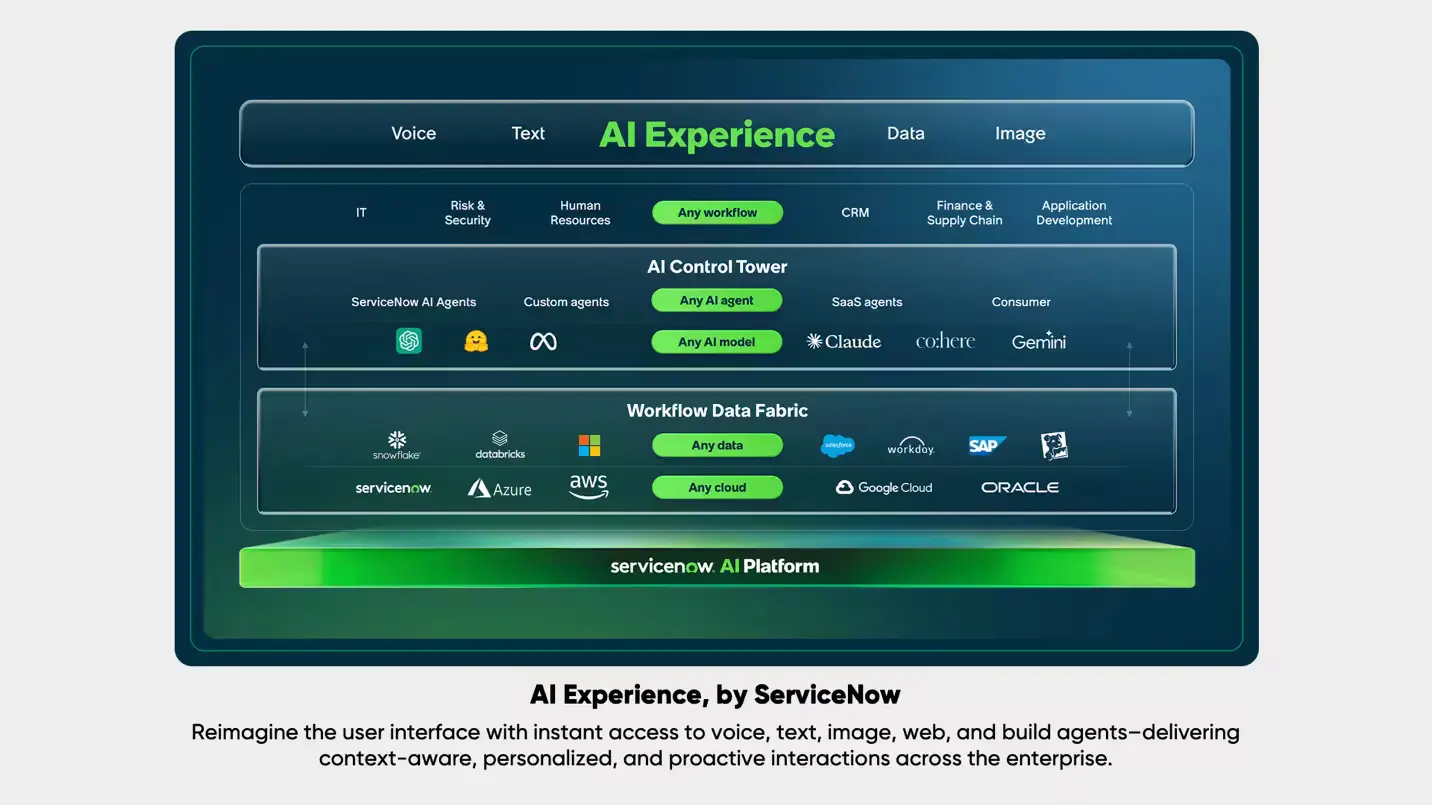ServiceNow AI Experience: A Complete Guide
Table of Contents
User experience has always been the heart of innovation, every technological leap, from touchscreens to virtual assistants. It has always been envisioned to make interactions faster, simpler, and more intuitive. Yet, in enterprise systems, that experience often remains fragmented. Employees still switch between tools, their crucial data sits in silos, and AI feels more like a background feature than an active part of their workflow.
This is exactly what ServiceNow aims to change with its recently launched AI Experience, which is designed to address the gaps in effective enterprise AI adoption. Interesting, isn’t it? ServiceNow’s AI Experience unifies AI, data, and workflows on a single platform. Basically, making a clear statement that “AI is the new UI”. In this blog, we will explore more about ServiceNow AI Experience, see how it works, and what impact it may have. Let’s begin!
What is ServiceNow AI Experience?
ServiceNow AI Experience is a platform-native orchestration layer and unified interface that integrates multiple AI capabilities into the ServiceNow AI platform (formerly known as Now Platform). The system is designed to work across departments such as IT, HR, customer service, and operations without their respective teams to requiring specialized AI expertise.
Here’s what it does:
- It adapts to industry-specific needs and is embedded directly into workflows.
- It allows users to interact with AI through natural language.
- It supports multimodal (voice, text, image, etc.) for contextual understanding and providing recommendations.
- It automates routine actions, freeing up teams to focus on high-value tasks.
ServiceNow AI Experience features
ServiceNow has also introduced new features in this new suite. Here’s an explanation of these features:

AI Web Agents: These agents can autonomously navigate and interact with external websites or browse the web, just like how a human agent would do, but way faster. They can complete multistep tasks like research or form-filling quickly.
AI Voice Agents: These agents with basic conversational voice commands can deliver hands-free support, solve problems, and even execute tasks.
AI Data Explorer: The explorer has access to data across the enterprise and even third-party systems due to Workflow Data Fabric. It also helps in transforming natural language queries into instant data insights, without having to leave their workflow.
AI Lens: The lens extracts data from any screens and images instantly and integrates the retrieved information into the workflows, eventually reducing manual data entry efforts.
How ServiceNow AI Experience Works?
Let’s take a closer look at how ServiceNow AI Experience operates through three foundational technologies:

Knowledge graph: Knowledge graph lies at the core of the AI Experience by ServiceNow. It is a unified semantic model that seamlessly links an enterprise’s data, workflows, and the user’s query intent together. It ensures that this single source of truth fosters contextually good collaboration between human teams and AI.
ServiceNow Workflow Data Fabric: The Workflow data fabric acts as the connective tissue between different data sources, structured and unstructured. It provides real-time visibility into processes and operations, giving AI agents the complete context they need to act intelligently without the silos.
AI Agents: These AI agents are an active layer of the experience. They are capable of executing tasks, triggering workflows, and making recommendations autonomously. They analyze inputs from the above sources, take proactive actions ( like resolving service requests, optimizing resources, or detecting/mitigating risks before they escalate).
Two essential oversight systems govern these components:
AI Control Tower: It offers a centralized visibility into the AI model behavior, performance, and compliance-related matters.
Guardrails: these are enforceable and responsible AI principles that can be pre-set to ensure the modal limits, accuracy, and security.
ServiceNow AI Experience benefits
Here, we have discussed the benefits and impact of ServiceNow AI Experience:
Increased productivity: ServiceNow AI Experience will automate routine and repetitive tasks, such as classification, routing, and resolution. This will reduce manual effort and allow teams to accelerate operational throughput.
Faster and more accurate responses: The virtual agents (along with the suite of new upcoming features) and Now Assist will deliver instant, contextual answers embedded in portals and forms. As a result, the employees and customers will receive timely, accurate responses, which will improve their overall satisfaction and user experience.
Improved decision-making: By leveraging unified data from the knowledge graph and real-time visibility via Workflow Data Fabric, leaders will be able to make informed, faster decisions. Eventually, improving their risk eversion capacity and resource optimization.
Trustworthy AI governance: The pre-set guardrails will ensure all automated actions comply with company policies, regulatory standards, and ethical practices. So that the enterprises gain confidence in AI-driven decisions, with full transparency and accountability.
Improved scalability: With this new orchestration layer, the native AI capabilities of the platform will be expanded across multiple departments and industry-specific workflows without rebuilding systems. This will ensure consistent operational efficiency and measurable long-term business impact.
Use case and impact
With the help of these use cases understanding of ServiceNow AI Experience will be enhanced:
Scenario 1: IT service management
An employee reports, “My laptop keeps freezing.”
- Problem reporting: Employee reports the laptop problem.
- Classify problem: Predictive Intelligence will identify the type and priority.
- Troubleshooting: Virtual Agent will then guide the employee through basic fixes.
- Context building: Later, Now Assist will show relevant past incidents or solutions.
- Performance tracking: Then the control tower will monitor the resolution accuracy.
- Result: reduction in issue resolution time and improved customer service efficiency.
Scenario 2: HR case management
An employee asks, “Can I carry forward my unused leave?”
- Problem reporting: The employee submits the leave query.
- Data gathering: Workflow Data Fabric will retrieve the real-time leave balance.
- Summarization: Now Assist, then will explain applicable HR policies.
- Compliance check: The guardrails will ensure the response follows rules.
- Resolution: eventually, the agent will provide clear, actionable guidance.
- Result: Accurate, immediate response with reduced HR workload.


End note
The ServiceNow AI Experience aims to provide operational value. The platform is designed for scalability, adaptability, and measurable impact, without the need for specialized AI expertise. It focuses on enhancing the collaboration between human resources and AI within organizations.
To leverage the full potential of ServiceNow AI Experience, you can consult with a ServiceNow consulting partner like Cyntexa. Our consultants will help you implement AI-driven workflows that enhance user experiences and accelerate business outcomes.
Schedule a consultation call today!
Don’t Worry, We Got You Covered!
Get The Expert curated eGuide straight to your inbox and get going with the Salesforce Excellence.
AUTHOR
Shruti
ServiceNow, Sales Cloud
Shruti is a ServiceNow Consultant with 5+ years of experience across ServiceNow ITSM, AWS, Salesforce Loyalty Management, and managed services. She blends technical expertise with strategic insights to deliver transformative IT services and CRM solutions that enhance efficiency and customer satisfaction.


Cyntexa.
Join Our Newsletter. Get Your Daily Dose Of Search Know-How












